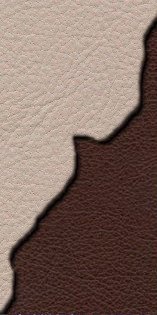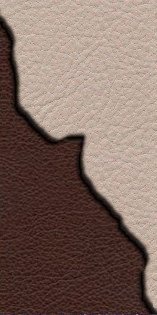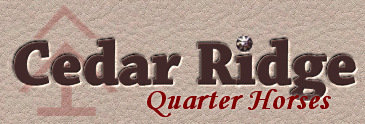

HOMOZYGOUS, OR NOT HOMOZYGOUS?
Definitions Sample Traits Facts Statistics The Old Fashioned %-age Belief Misconceptions
|
The question of whether horses are homozygous for a trait or not (or it's chance of being homozygous) is not really that hard to understand, but it takes someone good at math or good at explaining it to help understand the statistics sometimes. I'm not really good at explaining math, but am going to try here anyway. I have had a couple math experts check who agree, and it seems logical to me (yikes...logical? That could be my first dangerous assumption!).
Why would anyone care about homozygous or not homozygous?
People are often interested in a horse's genetic makeup for color because it helps to predict what colors of foals a horse can have. Example: Right now, it's desirable in many breeds to have horses with black legs. Knowing whether a stallion or mare is homozygous for black legs can help owners choose mates for their horses in order to produce the most desirable foal for the marketplace, family, or show ring.
But remember...quality is more important than homozygous color traits!
Definitions
What does homozygous mean?
Basically, it means that a horse has two copies of the same trait in its genetic makeup. But the important part of that is that if a horse is homozygous for a dominant form of a trait, then EVERY foal that horse produces will carry that trait. So for a homozygous roan mare or stallion, all foals he or she has will carry and express the roan trait.**
What does heterozygous mean?
Heterozygous means that a horse has one copy of a gene for a dominant trait, and one copy of a recessive (non-trait) at that location in its genetic makeup. This horse will produce or pass along the dominant trait (like dun factor, roaning, gray, black, etc.) 50% of the time. It also means that when bred to horses who don't carry that same trait, 50% of its foals will have the trait (once a sufficient number of offspring has been produced to produce valid statistics). Back to top.
Sample Color Traits
|
For horses homozygous for this dominant trait (other traits exist, but we aren't covering them all here) |
All foals will have this visual trait** |
| Black | Black legs, mane, tail |
| Dun factor | Dorsal stripe and other dun factor markings |
| Roan (yes, homozygous roans do exist! :-) | Roaning |
| Creme | Diluted body (buckskin, palomino, cremello, etc. except smoky blacks) |
| Gray | Foals will eventually turn gray |
**Exceptions are when another trait covers up the trait in question...for example, gray will dominate over all other traits eventually. A dun or roan foal from a gray parent can eventually be a simple gray (visually) without any dun factors showing. Also, two creme genes will make black legs LOOK cream or cinnamon, but genetically the foal is still black legged. Other exceptions exist.
Facts to Remember
Before proceeding, keep these things in mind:
-
BOTH parents must possess a trait in order for the foal to be homozygous for that trait. A red-legged mare bred to a black-legged stallion can not produce a foal that is homozygous for black. A sorrel mare bred to a dun stallion can not produce a homozygous dun.
-
There is no visual way to tell if horses are homozygous for most traits. A black horse that looks darker black is not necessarily homozygous. Duns with lots of stripes aren't necessarily homozygous. There are ways to tell about some traits, such as the tobiano pinto pattern and the creme gene. And don't forget sorrel...sorrel horses are homozygous for "non-black," or red. Breeding a sorrel to a sorrel will always produce a sorrel. But you can't visually tell the homo/heterozygous states for dun, roan, black, or gray.
-
There are tests for SOME traits, but not all. There are tests available, such as from the University of California at Davis (for about $50 each) that can tell you if your horse is homozygous or if it is heterozygous for black, the creme gene, the "bay gene" (Agouti...which actually is a red-body gene and is commonly found in sorrel-based horses as well as bays), pinto/paint traits, and more. There currently (2003) are NOT publicly-available tests for the dun and roan genes, and some other traits.
-
Statistics will vary depending on if the parents were homozygous or heterozygous for a trait.
-
Statistics will generally hold true once a horse has produced a viable number of offspring. This is known as the "Law of Large Numbers." For example, if a stallion's first 3 foals are all dun, it doesn't necessarily mean that he is homozygous for dun factor. Once a horse has his first 15 offspring in a row with a trait, we might assume that he/she is homozygous, but there's a chance that we would still be incorrect in that assumption. Also, percentages will become correct once enough offspring are produced. For example, a palomino stallion will produce 50% palomino and 50% sorrel foals from sorrel mares once he has bred enough sorrel mares to give statistics a chance to work out.
-
You have to separate the percentage chances of foals that aren't yet born (meaning that we can't SEE their color yet) from the percentage chances of horses that are already here whose color we CAN see. There will be different percentages for those two different situations.
The Statistics
To summarize the stats without explaining them, here's the math. Some more explanations will follow, as well as examples.
Both Parents Heterozygous
Prior to being born:
50% chance for sire to pass his color gene
x 50% chance for dam to pass her color gene
25% chance for receiving one from each parent
(homozygous)
After being born and seeing that the foal obviously has at least one color gene:
100% chance foal received at least one dominant color gene
x 50% chance that foal received that gene from the other
parent also
50% chance foal received color genes from both
parents (homozygous)
One Parent Homozygous
(let's assume it was the sire)
Prior to being born:
100% chance for sire to pass his color gene
x 50% chance for dam to pass her color gene
50% chance for receiving one from each parent
(homozygous)
After being born and seeing that the foal obviously has at least one color gene:
100% chance foal received at least one dominant color gene
from the homozygous sire
x 50% chance that foal received that gene from the other
parent also
50% chance foal received color genes from both
parents (homozygous). Here, we can't assume anything because
we know that the first color gene received was from the sire.
Both Parents Homozygous
Prior to being born:
100% chance for sire to pass his color gene
x 100% chance for dam to pass her color gene
100% chance for receiving one from each parent
(homozygous)
After being born and seeing that the foal obviously has at least one color gene:
100% chance foal received at least one dominant color gene
x 100% chance that foal received that gene from the other
parent also
100% chance foal received color genes from both
parents (homozygous)
Foal Example 1: Grullo filly from two non-homozygous parents
In the case of most of our foals, both parents carry one of today's popular color genes. Where the parents both have the SAME "color" gene (like dun, roan, or black), the following conversation will apply.
Let's assume you have a filly that had a sire and dam who both carried dun factor and black legs. What are the chances that she is homozygous for dun factor or for the black gene if she is grullo...born, on the ground, nursing, and obviously a grullo?
Before we begin, let's assume that the sire and dam of the filly were NOT homozygous for the color gene themselves...they had one dominant and one recessive allele for the color trait (dun and/or black). Non-homozygous horses (heterozygous for a trait) will throw their visible trait 50% of the time, and the recessive trait 50% of the time. That's why if you breed a palomino to a sorrel, you'll get 50% sorrels and 50% palominos over the long run.
Dun Factor
Each of her parents had a 50% chance of passing his/her dun gene along to her. Since we know that one of her parents did give her the dun allele (because she is grullo and has a dorsal stripe), that STILL leaves her other parent with a 50% chance of having passed his/her dun factor to her.
For example, let's say that her dam gave her the dun factor. We are 100% sure she gave her dun gene to the foal. That means that we are wondering whether or not the dun-factored sire also gave her HIS dun factor. Since he throws his dun gene 50% of the time, then there's a 50% chance that she got his dun gene also. The math is 100% x 50% = 50%, or
- 100% sure that at least one parent gave her the dun gene (because we can see it), and
- 50% chance that the other would also have passed along his/her dun gene, equals
- 50% chance she received the color gene from both parents, and 50% that
she didn't.
If you disagree with the above, think about it this way:
If you insist on saying that a foal from 2 heterozygous parents only has a 25% chance of being homozygous for a trait they both carry (and which the foal possesses), then what you are saying is something like this:
Example 1: A black foal from two bay parents has a 25% chance of being homozygous for the dominant form of Agouti if calculated before it is born. Once it's born, that is no longer correct! It can't happen...blacks don't even have a dominant form of the Agouti gene. They have two recessive alleles.
Example 2: A foal is born buckskin, from two parents that are buckskin. If you disagree with the paragraph above, then what you believe is that this buckskin foal has a 25% chance for being homozygous for cream. It can't happen...a buckskin has only one copy of the cream, or else it would be a perlino. The statistic calculated prior to birth no longer applies once the foal is born!
And the most plain way I can think of to describe this...
Example 3: A foal from two blacks that are NOT homozygous for black is born, and the foal is black. If you still believe in the old "what I've always heard is that there's a 25% chance he could be homozygous for black" theory, then what you believe is that this black foal has a 25% chance of being sorrel, 50% for heterozygous black, and 25% for homozygous black. Um...no. Period. Before it was born, there was a 25% chance it would be sorrel. But once it was born and you could tell it was NOT sorrel, you MUST re-figure your odds! That 25% chance for sorrel no longer exists because the foal is black, so there's proof positive that you must recalculate!
What I'm trying to point out here is that you have to
change your math
once the foal is born
when you can see some of its traits and know it received the gene you're
calculating.

Black/Red Gene
The same is true for the black gene in our grullo filly example. Before she was born (before we knew her leg color was black), her chances were:
25% chance for being homozygous for black if both
of her parents had genetically black legs.
25% chance for being red legged.
50% chance for having black legs, but not being homozygous for black.
However, once we could see that she had received a black gene from one parent because her legs were black, we only had to worry about the other parent giving her his/her gene. Each parent represents 50% chances, so therefore the unknown parent leaves her with a 50% chance for being homozygous.
Foal Example 2: Champagne foal from two non-homozygous champagnes
We have a champagne filly that has a champagne dam and a champagne sire. Neither are homozygous...so they are both heterozygous for champagne. What are the chances that this filly is homozygous for champagne?
Prior to her being born, we had no knowledge of her color, and therefore
didn't have any 100% confidence level in what she would be. So:
50% chance for Parent 1 to give her a champagne gene.
50% chance for Parent 2 to give her a champagne gene.
So, 50% x 50% = 25% chance for homozygous prior to being born.
50% chance for her being a champagne, but not homozygous for champagne
25% for her not being a champagne at all.
Once she is born, you don't have to guess at all of the characteristics (because you
can see that she is a champagne now that she has been born), you can figure
the probabilities taking into account what you actually know from looking at
the foal. This is why the statistics for a champagne foal (that is on the
ground) from two champagne parents are 50% for homozygous rather than 25%.
So in the case of our champagne filly:
We are 100% confident that Parent 1 did give a champagne gene because she is
a champagne.
We know that Parent 2 had a 50% chance of giving a champagne gene, because
both Parent 1 and Parent 2 are heterozygous.
So, 100% x 50% = 50% (once she was born and we could see that she
was in fact a champagne) chance that both parents gave champagne, and
that she is homozygous .

-
Horses that are homozygous for black do NOT always produce black foals. Horses that are homozygous for black can produce any color of foal that has black legs. All of their foals will have black legs.** But this includes bay, buckskin, grullo, blue roan, black-based grays, etc.
-
There currently are no publicly-available tests for some horse color traits. Tests are available for black, creme, Agouti (no black on barrel/neck, as in bays, buckskins, sorrels, etc.) and some others. But as of this writing, some traits do not currently have tests, such as dun and roan.
-
Both parents must carry a trait in order for a foal to be homozygous for that trait. For example, a sorrel bred to a black can NOT produce a foal that will be homozygous for black.
-
A horse will throw it's color trait (dun, roan, etc.) 50% of the time unless it is homozygous for that trait. It will not throw it 75% or 90% of the time...50% is the only option. If someone advertises their horse as a 75% or a 90% color producer, they are wrong unless it carries more than one "color gene," such as if it was a dunskin, dun roan, or dunalino. Most of the time that a heterozygous horse produces over 50% colored foals, it is because it is being bred to mates that carry that same color trait. Ex: a dun stallion being bred to dun and buckskin mares will produce more colored foals than the same dun stallion being bred to bay and sorrel mares.
-
If you know of other misconceptions, please e-mail me and I will be able to consider adding them here.
**Exceptions are when another trait covers up the trait in question...for example, gray will dominate over all other traits eventually. A dun or roan foal from a gray parent can eventually be a simple gray (visually) without any dun factors showing. Also, two creme genes will make black legs LOOK cream or cinnamon, but genetically the foal is still black legged.
Photo Ownership Notice:
All of the photos on this page are the property of Cedar Ridge QH's or were
sent to us with permission.
If someone has sent a photo to us for use on our pages that belongs to you,
and if they did not have
permission to do so,
please let us know.
If you are interested in contributing a photo, we thank you! But please do not
alter the photo or place your contact
information on it. Our educational pages are for just that...education. Not
advertisements. Thanks!
|
This page last updated 03/26/10
This page last updated
05/28/21
If you notice this date being 2 years or older, please let
us know that we need to check out this page!


Home Horses For Sale Stallions Mares Foals Blog Color Genetics Riding Horses Site Map Contact Us

Toni Perdew
Bedford, Iowa
toni@grullablue.com
712-370-0851 cell, before 9 p.m. CST
![]()
www.facebook.com/CedarRidgeQuarterHorses
Web design by
CR
Equine Sites.
All rights reserved. Graphics are watermarked for copyright protection.
Terms of Use
